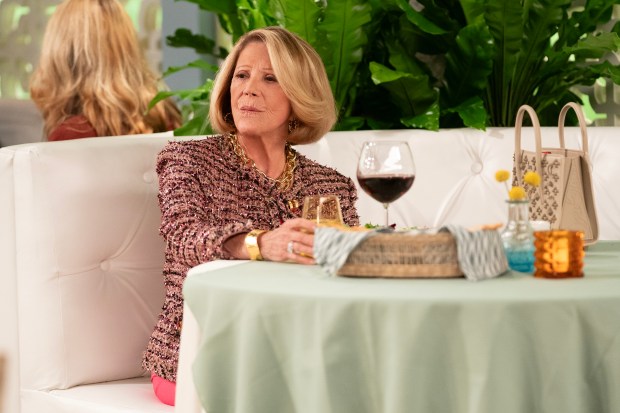Homage would be the kinder term, but no matter how you slice it, the Hulu sitcom “Mid-Century Modern” is a “Golden Girls” ripoff. Three gay best friends sans significant others — played by Nathan Lane, Matthew Bomer and Nathan Lee Graham — decide to become roommates and share a spacious home together. Instead of Miami, the setting is Palm Springs, which is a distinction without a difference when it comes to a vaguely gestured-at backdrop of palm trees and retirees.
I actually don’t mind the recycled template. In an era defined by old intellectual property reanimated into its latest zombie form, it was inevitable someone would reimagine this ’80s TV stalwart, which still holds up (boy, does it hold up). Technically, “Mid-Century Modern” is an original show, not a reboot. But in spirit? Rebootapalooza. Even the general layout of the set is reminiscent of the “Golden Girls” house. If only the similarities extended to the show’s quality overall.
The series comes from “Will & Grace” creators Max Mutchnick and David Kohan, who understand the mechanics and rhythms of a sitcom. The cast, however, does not (with one exception), which is perhaps why it feels like everyone is playing to the back row. It’s so bad in the pilot that I’m curious if people will stick around and keep watching. I hope so, because the show improves. Not enough. But it’s better than the first episode suggests.
The owner of the house is Bunny (Lane), a mostly retired founder of a Victoria’s Secret-esque company. His snazzy, opinionated mother also lives with him, and zingers aplenty from this one. She played by Linda Lavin, the only sitcom veteran in the main cast and who instinctually knows what’s required here. She’s brilliant. The newcomers to their abode are Jerry, a hunky Mormon flight attendant (Bomer), and Arthur, a haughty fashion doyen recently fired from Vogue (Graham). As longtime friends, this setup is just what they need at this point in their lives, with everyone feeling somewhat adrift.
All good, in terms of the general framework. I’m dying — dying — for a traditional-style sitcom, laughtrack and all, that really works. The great James Burrows directs, and his legacy includes everything from “Cheers” to “Friends.” What could go wrong?
Quite a bit, actually. The show keeps getting in its own way, mostly because the characters lack distinct personalities. Bunny is … a lot? Arthur is … a lot too, but with a supercilious edge? Jerry is … blissfully dim? (He’s the obvious “Golden Girls” corollary, playing a version of Rose). These barebones traits don’t help you peg who they are in this little world. What do they want, as individuals? What is their comedic function within the show? None of this has been worked out. The creators go heavy on ribald, sometimes overworked, banter — “You don’t look sad, you just look like a reluctant bottom” — which in general can be fun (though in lighter doses than we get here), but only if it feels specific to each character, not just a dirty line anyone in the scene would rattle off.
That’s where “The Golden Girls” could have been instructive, because the punchlines on that show are tailored to each person’s nature and temperament and outlook on life. If “Mid-Century Modern” had a clearer idea of who its central characters were (aside from Lavin, who is perfect), the sweaty need to sell, sell, sell every joke probably wouldn’t weigh on everyone so heavily. When Bunny becomes flustered in front of an attractive man, the double entendre tumbles out of his mouth as he likens the hot guy’s storytelling skills to a one-man stage show: “People would definitely come, I’d come every night!” But Lane’s delivery doesn’t finesse the line so you laugh despite yourself; the delivery feels focused on ensuring audiences get it. Yes, we get it. Stop pushing so hard. Lane is a wonderfully versatile actor, it’s troubling to see him working to overcompensate for such an amorphously written role.
They all get COVID in one episode and are stuck at home trying to amuse themselves, and I at least appreciate that a TV show — any TV show — is acknowledging that COVID is still an ongoing reality. Another storyline sees the men taking a trip to Fire Island to recapture their youth, which doesn’t go as planned, and it’s one of the season’s strongest episodes. Pamela Adlon shows up occasionally as Bunny’s younger sister and she brings a much needed piquant energy to the proceedings. Bomer is good when Jerry the ding-dong must navigate a moment of real sentiment or complication; the juxtaposition is effective.
But overall the show is missing the kind of scenes that allow the core ensemble to sit around the kitchen table and share absurd stories with one another about their lives.
Lavin died in December at 87, before filming on the season finished. “I’m thrilled you’re gonna move in here,” she says to her son’s friends, “it’s gonna be so good for Bunny to not be alone when I’m gone, which won’t be for a long while!” She yells that last part for emphasis. It’s a line that leaves a lump in your throat.
Her death is incorporated into the final two episodes, leaving the show with an unfillable hole. The finale suggests that if the show is renewed, the creators might simply add yet another gay guy to the mix. But that doesn’t change up the energy the way Lavin’s character did. Her glamorous and slightly tacky presence served to pour cold water on whatever emotional spiral the men were in the midst of, and that was a source of real comedy. If there’s a Season 2, here’s hoping the show can conceive of the right kind of person — and the right kind of actor — who can recreate that energy.
“Mid-Century Modern” — 2.5 stars (out of 4)
Where to watch: Hulu
Nina Metz is a Tribune critic.




